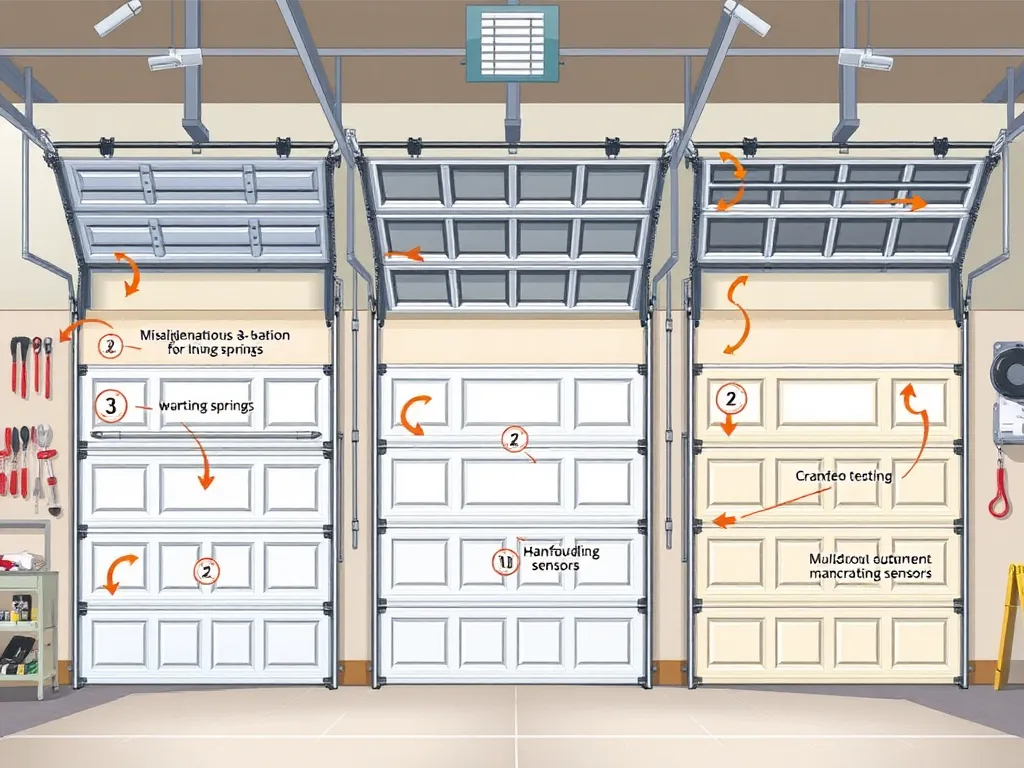Common Issues Found During Garage Door Safety Testing - Tips

The Importance of Garage Door Safety Testing
Garage Door Safety Testing is an essential practice for ensuring the functionality and safety of garage doors. Regular testing helps identify potential hazards that could lead to accidents or injuries, protecting both users and vehicles. Garage doors are heavy and operate with powerful mechanisms, making safety testing a crucial aspect of home maintenance. By understanding the importance of these tests, homeowners can prevent malfunction and ensure their garage door operates smoothly and safely.
Conducting Garage Door Safety Testing involves a series of checks that monitor the door's operation, sensors, and overall condition. Tests typically include examining the door's automatic reverse mechanism, inspecting the springs, and ensuring that safety sensors are functioning correctly. Regular testing not only guarantees safety compliance but also extends the lifespan of the garage door, reducing the likelihood of expensive repairs or replacements in the future.
One of the key components of Garage Door Safety Testing is the evaluation of safety features designed to prevent accidents. Testing these features helps in identifying any wear and tear that might compromise their effectiveness. Homeowners should understand that neglecting such tests can lead to serious safety risks, including entrapment or damage to vehicles. Therefore, routine garage door safety checks are not just good practice but a necessary preventive measure.
A common issue homeowners face is sensor misalignment, leading to malfunctioning garage doors.
In addition to mechanical testing, Garage Door Safety Testing also addresses the emotional aspects of safety. Homeowners often experience anxiety about the reliability of their garage doors, fearing potential malfunctions that could endanger family members or pets. By conducting regular safety tests, such worries can be alleviated, as owners gain confidence in the safety and functionality of their garage doors, contributing to their peace of mind.
Ignoring signs of obstruction detection failure can result in serious safety hazards and costly repairs.
In summary, Garage Door Safety Testing is not only about compliance and functionality; it is about ensuring a safe home environment. By prioritizing regular safety checks, homeowners can avoid accidents, ensure smooth operation, and extend the life of their garage systems. Embracing safety testing is a small commitment that reaps substantial rewards in peace of mind and safety.
Emotional Factors in Garage Door Safety
The emotional impact of a malfunctioning garage door can be significant. Homeowners often fear that the door will fail to operate correctly when needed, leading to potential accidents. This fear of malfunction can create a sense of unease, especially if the garage is used frequently for family members entering and exiting the home.
Many garage door problems stem from wiring issues, which can disrupt the entire system's functionality.
Another emotional factor is anxiety regarding safety compliance. Many homeowners worry whether their garage doors meet safety regulations, and failure to comply with these standards can lead to liability issues in the event of an accident. Regular Garage Door Safety Testing helps alleviate this anxiety by ensuring that all features are functional and compliant with safety standards.
Frustration with repeated repairs is another emotional factor that homeowners experience. If a garage door consistently requires attention due to faulty sensors or worn-out parts, it can lead to feelings of annoyance or helplessness. By committing to regular safety testing, homeowners can effectively mitigate these frustrations by addressing issues before they escalate into major problems.
Mechanical Issues That Compromise Safety
Worn-out springs and parts are common mechanical issues that can compromise garage door safety. Springs endure significant tension and, over time, can weaken or break, posing risks during operation. Regular safety testing includes inspecting these components to ensure they are in good condition, which is critical for safe operation.
Faulty wiring and sensors can also contribute to mechanical failures and safety hazards. If the wiring is frayed or the sensors are misaligned, the door may not function as designed. Regular testing allows homeowners to identify these faults early, preventing potential accidents and ensuring reliable operation at all times.
Misaligned doors affect operation and can lead to accidents if not corrected. Inconsistent movement or sticking doors can create dangerous situations, especially if the door fails to respond to safety features. Garage Door Safety Testing provides an opportunity to realign and properly calibrate doors, ensuring smooth and safe operation.
Common Safety Protocols for Testing
One of the primary safety protocols is conducting regular inspections and maintenance. Homeowners should create a schedule for inspections to ensure their garage doors are functioning correctly and safely. This proactive approach minimizes the risk of mechanical failure and enhances the overall safety of the garage.
Testing the auto-reverse functionality is another crucial safety protocol. This feature is designed to prevent the door from closing on objects or people. Ensuring that this function operates correctly during safety testing is vital, as it directly impacts user safety and compliance.
Checking open/close limits is also an essential safety protocol. By regularly testing these limits, homeowners can ensure that the garage door opens and closes correctly without any obstructions, reducing the risk of accidents or injuries associated with improper operation.
Solutions and Fixes for Garage Door Issues
When common faults are identified during Garage Door Safety Testing, immediate repair options should be pursued. Homeowners can often address simple issues such as resetting sensors or lubricating moving parts. For more complex issues, a professional inspection may be needed to ensure safety and functionality.
Recommendations for safety features include installing state-of-the-art sensors, automatic reverses, and motion detectors. By enhancing the safety features of garage doors, homeowners can significantly reduce the risk of accidents and improve the overall safety of their homes.
Hiring a professional for testing is crucial when homeowners lack the expertise to perform safety checks themselves. A trained technician can provide comprehensive testing, identifying subtle issues that may be overlooked. Regular professional evaluation should complement DIY checks for optimal safety and functionality.
Preventative Measures for Garage Door Safety
Installing safety sensors is a vital preventative measure for enhancing garage door safety. These sensors can detect obstacles in the door's path, thus preventing accidental closings that could harm individuals or damage vehicles. Regular testing ensures that these sensors remain functional and responsive.
Setting regular maintenance schedules is a preventative measure that can save homeowners time and money. By scheduling annual or semi-annual safety tests and inspections, homeowners can stay ahead of potential issues, reducing the likelihood of emergency repairs and ensuring the mechanism's longevity.
Educating users on safe operation is necessary for maximizing garage door safety. Homeowners should understand how to use their doors properly and what signs of malfunction to watch for. Awareness of these safe practices helps prevent accidents and promotes a culture of safety in the home.
